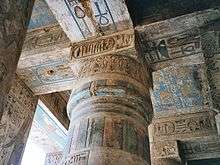Peristyle
In Hellenistic Greek[1] and Roman architecture,[2] a peristyle (/ˈpɛrɪstaɪl/; from Greek περίστυλον)[3][4] is a continuous porch formed by a row of columns surrounding the perimeter of building or a courtyard. Tetrastoon (τετράστῳον or τετράστοον, 'four arcades')[5] is a rarely used archaic term for this feature. The peristyle in a Greek temple is a peristasis (περίστασις).[6] In the Christian ecclesiastical architecture that developed from the Roman basilica, a courtyard peristyle and its garden came to be known as a cloister.


In Roman architecture
In rural settings, a wealthy Roman could surround a villa with terraced gardens; within the city, Romans created their gardens inside the domus. The peristylium was an open courtyard within the house; the columns or square pillars surrounding the garden supported a shady roofed portico whose inner walls were often embellished with elaborate wall paintings of landscapes and trompe-l'oeil architecture. Sometimes the lararium, a shrine for the Lares, the gods of the household, was located in this portico, or it might be found in the atrium. The courtyard might contain flowers and shrubs, fountains, benches, sculptures and even fish ponds.[7] Romans devoted as large a space to the peristyle as site constraints permitted; even in the grandest development of the urban peristyle house, as it evolved in Roman North Africa, often one range of the portico was eliminated, for a larger open space.[8]
The end of the Roman domus is one mark of the extinction of late antiquity (the Late Classical culture): "the disappearance of the Roman peristyle house marks the end of the ancient world and its way of life," remarked Simon P. Ellis.[9] "No new peristyle houses were built after A.D. 550." Noting that as houses and villas were increasingly abandoned in the fifth century, a few palatial structures were expanded and enriched, as power and classical culture became concentrated in a narrowing class, and public life withdrew to the basilica, or audience chamber, of the magnate. In the Eastern Roman empire, late antiquity lingered longer: Ellis identified the latest-known peristyle house built from scratch as the House of the Falconer at Argos, dating from the style of its floor mosaics about 530–550.[10] Existing houses were subdivided in many cases, to accommodate a larger and less elite population in a warren of small spaces, and columned porticoes were enclosed in small cubicles, as at the House of Hesychius at Cyrene.[11]
Other uses
Although ancient Egyptian architecture predates Greek and Roman architecture, historians frequently use the Greek term peristyle to describe similar, earlier structures in ancient Egyptian palace architecture and in Levantine houses known as liwan houses.
Notes
- J.A. Dickmann. "The peristyle and the transformation of domestic space in Hellenistic Pompeii", Journal of Roman Archeology 1997.
- A. Frazer, "Modes of European Courtyard Design before the Medieval Cloister" Gesta, 1973; K.E. Meyer, "Axial peristyle houses in the western empire," Journal of Roman Archaeology, 1999; S. Hales, The Roman House and Social Identity 2003.
- Harper, Douglas. "peristyle". Online Etymology Dictionary.
- περίστυλον. Liddell, Henry George; Scott, Robert; A Greek–English Lexicon at the Perseus Project.
- τετράστοον in Liddell and Scott.
- περίστασις in Liddell and Scott.
- E.B. MacDougall, W.M.F. Jashemski, eds., Ancient Roman Gardens: Dumbarton Oaks Colloquium on the History of Landscape Architecture, 1979.
- Yvon Thébert, "Private life and domestic architecture in Roman Africa", in Paul Veyne, ed. A History of Private Life, I: From Pagan Rome to Byzantium (1985, Arthur Goldhammer, tr., 1987) esp. "The peristyle", pp 357-64.
- Simon P. Ellis, "The End of the Roman House" American Journal of Archaeology 92.4 (October 1988:565-576) opened the article's abstract with these words.
- Ellis notes G. Akerström-Hougen, The Calendar and Hunting Mosaics of the Falconer in Argos, Stockholm, 1974; a somewhat later peristyle house, at Hermione in the Peloponnesus, of the end of the 6th century, was not initiated at this late date but a partial reconstruction of an earlier elite dwelling (Ellis 1988:565).
- Noted by Ellis p. 567.
External links

- Barbara McManus, "The Peristylium": a reconstruction of a peristyle